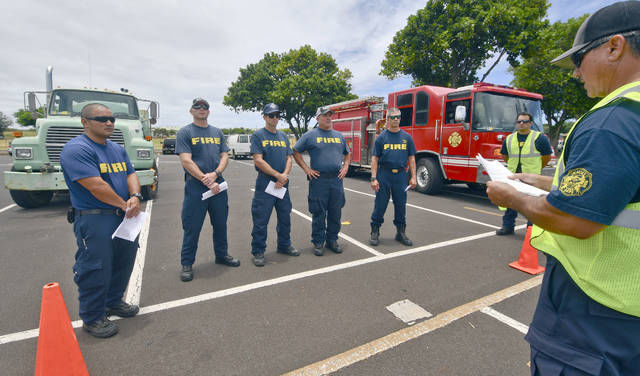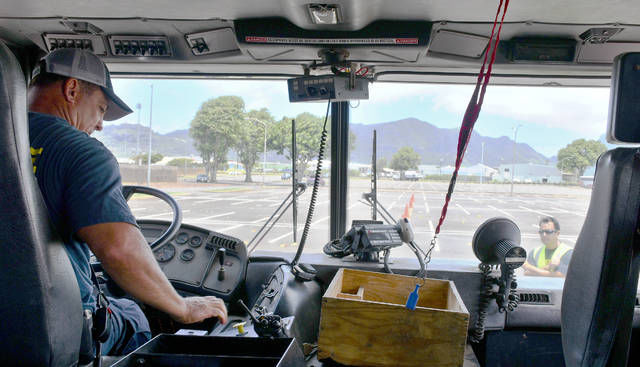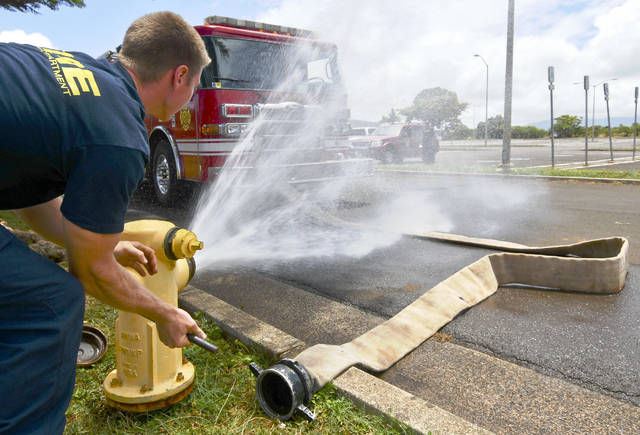LIHUE — Tim Stokesberry, a firefighter with the Kauai Fire Department, kept a firm hand on the controls as he navigated a firetruck through an obstacle course at Vidinha Stadium. After practicing making a right-hand turn, he drove through a
LIHUE — Tim Stokesberry, a firefighter with the Kauai Fire Department, kept a firm hand on the controls as he navigated a firetruck through an obstacle course at Vidinha Stadium.
After practicing making a right-hand turn, he drove through a re-creation of a narrow road, parallel parked, then maneuvered the truck through a series of cones.
Once he successfully completed the serpentine, he did it again, but in reverse.
Stokesberry, along with the rest of the KFD team, were taking part in driver training to be re-certified to drive firetrucks.
“These guys don’t always get a chance to drive because there’s a driver for calls,” said Cy Akaji, a firefighter in charge of training. “It’s about being safe out there and getting techniques so they feel comfortable driving.”
To be re-certified, firefighters have to complete a road test and an obstacle course. The test is comparable to that of a commercial driver’s license, Akaji said. But the driver training is just one aspect of the continuous training firefighters do on an annual basis.
Doing it all
From first responder training and fire operations to extraction, rope rescue, swift water rescue and hazmat, Kauai firefighters are expected to be proficient and ready to tackle any kind of emergency.
In addition to getting hands-on training, they also do pre-fire planning and go to businesses to look for potential fire hazards.
“Our job is not just fire-centric. It’s diversified. We do rescues — on land, in the water and in the air,” said Kilipaki Vaughan, deputy fire chief. “There’s a whole host of different skills and responses, so that’s the impetus to making sure we get enough annual training.”
Emergency personnel gets 6,000 calls a year, and 85 percent of them are for EMS. They also receive about five calls for rescue a week, he said.
A lot of the scenarios firefighters train for are low frequency, high risk — meaning they don’t happen a lot, but when they do, it can have a dramatic effect on those involved, Vaughan said.
“We want to be prepared to act accordingly,” he said.
Training for the job
In total, Kauai firefighters clock in about 120 days and 480 hours of training a year. The minimum hours required is between 250 and 300 hours, Vaughan said.
“The skill set is great, and we don’t always use them,” he said. “We say the skills are perishable — if you don’t use it, they tend to fade on you. But again, it’s muscle memory and practice. Not just the formal practicing of coming to a workshop, but practicing in the field.”
Extraction is an example of something that isn’t used often, but an important skill to be kept up-to-date on, Vaughan said.
Mike Scovel, a training captain, said an ever-changing design in cars keeps firefighters on their toes.
Another aspect of training is learning to fight fires in solar farms, Vaughan said.
“The more innovation happens, oftentimes, the more innovative we become in our skill set and try to react to that, and the more reason to train,” he said.
KFD recruits were also at Vidinha Stadium Monday, going through fire attack techniques like tapping and flushing a fire hydrant and driving up to the scene of a fire.
“It’s the oldest training the youngest. We’re capturing the institutional memory,” Vaughan said.
It’s part of a three-week course, said James Read, training captain.
“The first week was learning basic skills in a classroom. Now, we’re at the practical side,” he said. “By the end, they should be very solid with their skills.”
Currently, KFD is in the middle of getting every firefighter EMT certified, which includes over 200 hours of training that spans over eight weeks.
“I look at us as the front-line responders that get one scene, stabilize the patients and hand them off to greater care,” Vaughan said.




